Ash Wednesday 1983, and the death of two fire-fighters in the tragic bushfires.
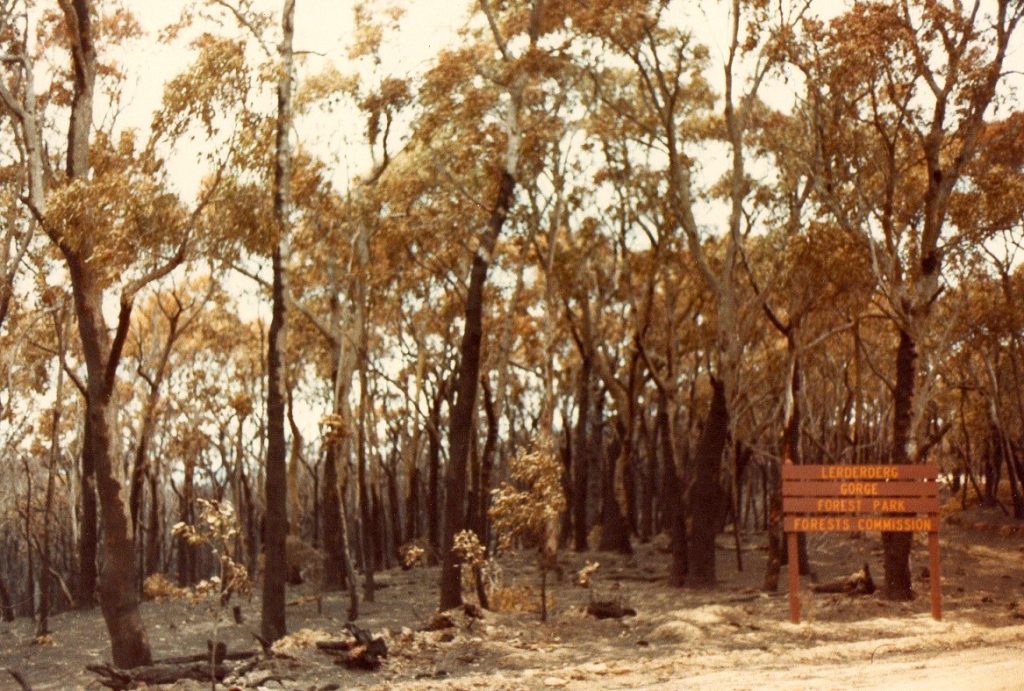
Burnt out area in Mt. Blackwood Road, Blackwood. photo taken by Margot Hitchcock 1983.
Remembering Ash Wednesday and Greendale Bushfires 8th January 1983.. at Blackwood. Courtesy Margot Hitchcock, Historian for the Blackwood & District Historical society.
Ash Wednesday (8th January 1983) experienced over 100 fires swept across Victoria and South Australia, killing 75 people and causing widespread damage. High temperatures, intense winds, and low summer rainfall caused a high fire danger in Victoria’s eucalypt forests.
A total of 47 people died, and 2,080 homes were destroyed in Victoria. Many businesses, stores, equipment, machinery, stock, and other private assets were also destroyed. The total cost of the property-related damage in Victoria was estimated to be over $200 million.
Between 1979 and 1983 almost all eastern Australia was affected by a major drought. Throughout Victoria, in the 12 months prior to January 1983, rainfall was less than 70 % of the long-term average.
The summer of 1982-83 is best remembered for the Melbourne dust storm on 8 February, followed a week later by the catastrophic Ash Wednesday bushfires on 16 February, but other significant fires occurred across the State.
The Country Fire Authority (CFA) attended nearly 3,200 fires over the summer, and 22 Total Fire Ban Days (TFB) were declared.
The Forests Commission Victoria (FCV) attended 823 bushfires within their legislated Fire Protected Area (FPA), having a total area of 486,030 ha, which was well above the eleven-year average of 141,000 ha.
It was an unusually long fire season for the Commission which began in August 1982 with a 3,400 ha fire in the Little Desert, and concluded nine months later in April 1983 with a 6,400 ha bushfire in the Grampians.
In addition to Ash Wednesday, the Commission was heavily engaged in two large campaign bushfires at Cann River in East Gippsland.
Just weeks before Ash Wednesday, on Friday 7 January 1983, another Total Fire Ban was declared across Victoria for the following day. Forests Commission crews together with the CFA were put on a heightened state of readiness.
The weather forecast for Melbourne on Saturday 8 January 1983, was for a fine, very warm to hot day of 29 degrees, with a freshening northerly wind of 10-15 knots on the Bay, increasing to 15-20 knots ahead of a mild south westerly change of similar strength during the afternoon or evening, with a chance of a thundery shower. These conditions represent moderate to a high Forest Fire Danger Index (FFDI).
It is many years since Ash Wednesday fires, but lets not forget the Blackwood/Greendale fires where 2 men named Des Collins and Alan Lynch lost their lives at Long Gully in Greendale while creating a firebreak trail. RIP. Click on the link for the full story … https://victoriasforestsbushfireheritage.com/…/greenda…/
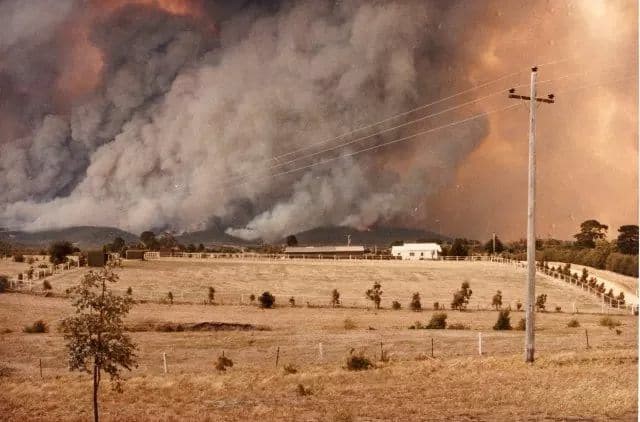
Bush fires in Greendale on the 8th January 1983.
Detailed Report – Greendale Bushfires 8th January 1983..
At 03.15 am on Saturday 8 January, a bushfire in the vicinity of Greenhills and Binks Roads, about 5 km north of the small settlement of Greendale, was reported by the Ballan CFA to the Forests Commission Duty Officer, and experienced forest overseer, Bernie Rogers, at the Commission’s office at Daylesford.
Graeme Shultz, a forest foreman, was immediately deployed to investigate, and he arrived around 04.00 am.
Significantly, Friday evening was unusually warm with a minimum temperature of 18 degrees at 11.00 pm, and by 01.00 am it had risen to 22 degrees, while the Relative Humidity (RH) had fallen to 19%. The temperature stayed at 22-23 degrees until about 09.00 am on Saturday morning, and it rose to about 34.5 degrees at 3.00 pm. The RH remained low until the cool change late on Saturday afternoon.
The winds varied from 30-35 km/hr from the southeast at 04.00 am, and became gusty from the northwest around 06.00 am.
There were three separate fires but two had already been checked by the six CFA units in attendance, while the other was a cause of major concern. Jack Rankin was controlling the CFA crews under a separate command structure to the FCV.
The fire was burning freely in the bush on both sides of Greenhill Road when Graham Shultz arrived in the early hours. There was no doubt that this bushfire could develop into a major incident if the third blaze could not be brought under control quickly.
A small privately owned bulldozer under the control of the CFA was already working on the western flank of the fire.
While the causes were never formally identified by the Police, all three fires started around 01.00 am very close to each other, so most suspected arson.
The forests near Greendale are typical of the Wombat area which include messmate (Eucalyptus obliqua), broad-leaf peppermint (E. dives), narrow-leaf peppermint (E. radiata), with manna gum (E. viminalis) and candlebark (E. rubida). The forests are open on the ridges with a grass understory which get thicker in the wetter gullies.
The area hadn’t been burnt for decades and it’s likely the forests carried heavy fuel loads of more than 25 tonnes per hectare.
More importantly, messmate has a fibrous bark which is very prone to generate massive short-distance fire spotting when fuel moisture contents drop below 10%.
Local Daylesford FCV crew including Ian Tori, Neil Slater, Des Collins and Alan Lynch were immediately dispatched to Greendale with the Bedford tanker and a 4WD Slip-On-Unit (SOU). Alan then returned to Daylesford to pick up the dozer and float.
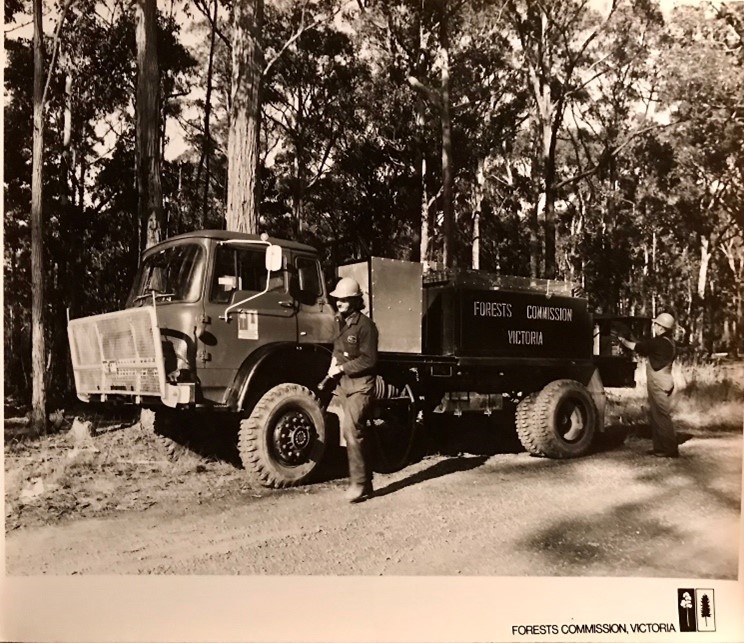
Daylesford Tanker courtesy of the Forests Commission.
The District Forester David Paterson was notified, and he came to the office around 04.15 am. Not long after he arrived, Bernie Rogers went to the fire ground on the corner of Greendale and Binks Roads with three portable radios and took charge of the FCV operations.
Other FCV District crews from Creswick, Beaufort and Trentham were dispatched to the fire including a small First Attack Dozer (FAD) from Trentham.
Around 07.00 am, Alan arrived back at Greendale with a large Forests Commission Komatsu D65A bulldozer which was stationed in the district at the time. Alan Lynch and Des Collins were deployed to operate it with Alan driving and Des off-siding and trail marking. Both were experienced machine operators and they often swapped roles.
Their task which began around 07.15 am, was to cut a fire trail from Greenhills Road into Dales Creek along the north eastern flank of the fire. They took a portable radio with them and regularly reported their progress.
Around 07.00 am, backburning began with the FCV and CFA along Bee Track to consolidate the western edge.
At about 08.00 am Jack Channon, the Divisional Forester from Ballarat, directed John Nankervis the assistant District Forester from Trentham, to go directly to Greendale to act as the Fireboss. The assistant from Daylesford, Jim Blain, was on leave at the time.
John had a well-deserved reputation for being an experienced, knowledgeable and cautious firefighter. He met with Bernie Rogers for a handover and then took charge.
It was an entirely normal arrangement to have an FCV fireboss in the field directing operations. The 1982-83 bushfires were before the adoption of the AIIMS Incident Control System (ICS).
So by 08.00 am, FCV forces working on the fire, or heading towards it, were:
33 firefighters (including 2 in the Daylesford office).
1 Bedford tanker
5 Slip-On-Units (SOU)
1 First Attack Dozer (FAD) from Trentham
2 Komatsu 65A dozers
1 Komatsu 85A dozer
The CFA numbered about 20 units, 10 private units plus one dozer and spotter aircraft. They were mainly working on the southern edge along the private land interface and around houses.
Jack Channon also proceeded to the fireground at Greendale.
Les Shultz, another very experienced forest officer with over 27 years at Daylesford, was dispatched to the fire to liaise closely with the CFA and Police. He arrived at Greendale with Reg Fuller around 08.30 am
A bit later around 09.30 am the HQ of both the CFA and Forests Commission shifted outside the Greendale Hotel. This is on a major road junction and was a logical staging point and where there were landline telephones.
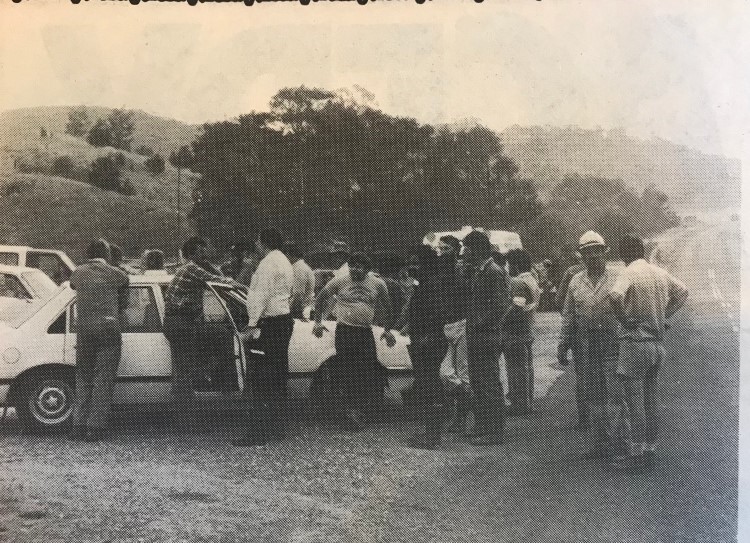
HeadQuarter of both the CFA and Forests Commission outside the Greendale Hotel.
A bigger FCV Komatsu D85A bulldozer arrived around 10.00 am and was set to work to extend a line along a spur into Dales Creek heading west along Charcoal Track from the Greendale – Trentham Road. Steven Tilley was off-sider.
This was as a second line of defence to protect the small settlement at Dales Creek to the northeast of the fire. The intention was that the two FCV machines would eventually link-up to form a continuous control line.
Around 11.00 am the Trentham crew, led by Kevin Noonan, was deployed with the Daylesford tanker to patrol Greenhills Road from the junction of the new trail constructed by Des and Alan down as far as the open farmland and the CFA.
Additional tankers and more Trentham crew, in three Slip-On-Units, together with a small John Deer FAD normally based with the FCV at Trentham, and driven by Graham Ryrie and John Bell, patrolled the flanking fire trail constructed by Des and Alan from Greenhills Road to Dales Creek.
A CFA reconnaissance aircraft with Jeff Brisbane, District Forester from Ballarat as air observer, was overhead by about 08.00 am relaying intelligence to John Nankervis on the ground at Greendale. But there were no fire bombers on Saturday, however two were deployed on Sunday from the CFA airbase at Fiskville.
The fire was relatively small by 08.00 am (about 120 Ha) and the fire behaviour was moderate. Crews on the line felt confident.
The strategy was to contain the fire within the new dozer trail being constructed by Des and Alan along the northeast flank down the spur into Dales Creek. They were to track along Dales Creek towards the south a couple of hundred metres to reach the open farmland. The southern edge along private property was grassland being secured by CFA tankers. A line in the bush along Bee Track towards Garibaldi Hill became the western boundary and was being backburned and patrolled by the CFA and FCV.
Under this initial first attack plan the fire would have been contained, mostly within State forest, but the fire holding along Dales Creek long enough to build a control line towards the south was critical.
Progress was good, and by 11.00 am Des Collins and Alan Lynch in the Komatsu D65A had reached the edge of Dales Creek.
Des advised John Nankervis that even though it was a steep drop they would proceed down into the gully. Critically, they also advised that vehicles, and the small Trentham FAD, behind them should not proceed pass this pinch point.
But not long after they had gone down over the steep slope with the dozer, Jeff Brisbane in the aircraft overhead reported that the fire had spotted over Dales Creek.
Des and Alan were immediately notified by John Nankervis. They confirmed they could see the flames ahead of them and they attempted to put a control line around one of the small spot fires but were heard to say around 11.30 am that “the fire was beating us”.
The loss of Dales Creek as a potential control line was a significant setback and required a quick change of tactics. Rather than tracking a short distance south along the creek towards the CFA on the private property as originally intended, a new control line would need to be constructed towards the east to join up with Charcoal Track and the second FCV machine working in the Greendale – Trentham Road area.
Around 11.30 am, after discussions with John Nankervis, Des and Alan began working directly along the fire edge towards the east.
Importantly, vehicles and tankers could not access this section of line until they broke through to Charcoal Track. A short time later Des requested additional crews on foot to patrol the new line east of Dales Creek to avoid it being lost.
At noon, the Daylesford office transmitted the following weather forecast – temperature 28 degrees, RH 20%, N-NW winds 15-20 km/hr. A major change with winds 30-40 km/hr from the southwest was expected to reach Greendale between 12.00 and 2.00 pm.
Radio contact was maintained with FCV fire towers west of the Greendale fire to monitor the progress of the change, which arrived at about 3.00 pm, and well after the “blow up” at 1.00 – 1.30 pm.
Ivan Sartori, an experienced officer based at Trentham, was immediately dispatched with six men from FCV Creswick to patrol the new line. They did not have a portable radio and arrived at the bottom of the drop-off in Dales Creek at 12.30-1.00 pm and could see that fire had spotted over the new control line on the other side of the gully, but it was backing slowly into the wind.
However, they decided they could do very little with just hand tools and climbed back up the hill to report the situation to John Nankervis.
Ivan reassuringly reported that the wind was light in the gully, and they could hear Des and Alan’s machine ahead of them in the bush.
The fire behaviour was still moderate and there was every reason to expect that it could be controlled.
The Rate of Spread (ROS) of the fire was slow, with low flame heights, until after 1.00 pm, particularly in the gully where Des and Alan were working.
John immediately contacted Des to let them know that the line had been breached by a spot fire behind them. Des reported that they had built about 2 km of trail east of Dales Creek and were close to breaking through to Charcoal Track. John instructed them to continue work along the line, but to stay close to the burnt edge, and keep in contact.
This was probably their last message…
The District Forester David Paterson arrived at Greendale around 1.00 pm and remained until about 5.00 pm.
The tempo of the fire began to escalate between 1.00–1.30 pm. However, it is very common for bushfires to flare up in the afternoon as temperatures rise and relative humidity drops. The extreme drought conditions were undoubtedly a major factor.
Ivan and his crew withdrew and were directed by John Nankervis to stay on the western side of Dales Creek on top of the hill on burnt ground and not go any further. They waited for the main fire coming up from Dales Creek to pass before retreating to Greenhills Road.
Around the time that the fire began to flare up, Kevin Noonan also advised John Nankervis he was pulling the Trentham crew, together with the tanker and slip-ons, which had been working on the western side of Dales Creek, back to Greenhills Road. This was a normal safety procedure.
Meanwhile, the two large FCV bulldozers had still not met up and Daylesford Overseer John Edwards was directed to find the second machine working on Charcoal Track near the Greendale – Trentham Road and take charge of its movements.
From about 1.30 pm the wind unexpectedly and violently began gusting up to 70 km/hr. The wind direction switched repeatedly backwards and forwards from the northwest to the southwest and the fire behaviour became very erratic.
The severe wind squalls caused mass spot fires which breached control lines in several locations around the entire perimeter. Hours of work were lost in minutes.
The swirling fire became uncontrolled and headed towards the small settlement of Dales Creek. It also breached the CFA control lines along the southern private property boundary.
Under the influence of the strengthening winds from the north west the fire spread rapidly towards open country and Bacchus Marsh. Later at 2.15 pm the BOM issued a gale warning for all southern Victoria with winds gusting to 70 km/hr or higher. A cold front was due in a line through Geelong to Warracknabeal at 2.00 pm which could reach the Greendale fire between 3.00–6.00 pm. This latest forecast was passed onto John Nankervis by Wally Sweet in the Blackwood fire-tower.
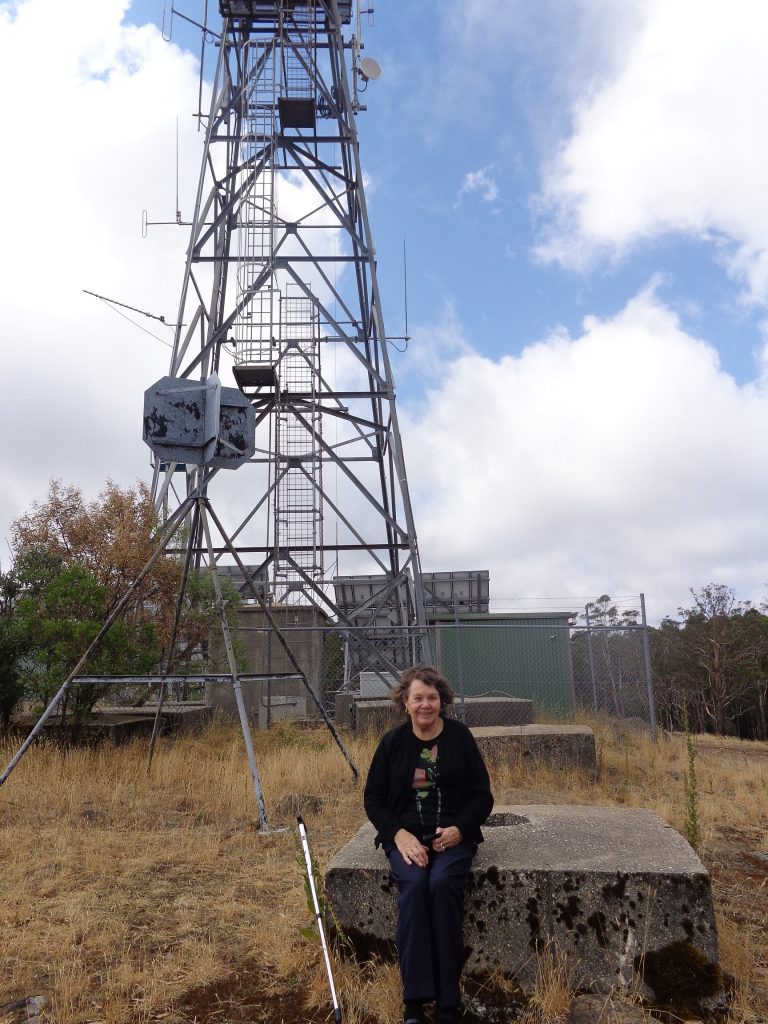
Blackwood Fire-Watch Tower at Mt. Blackwood with Margot Hitchcock. 2016.
Under these wind conditions the FFDI would have exceeded 50, or extreme, for parts of the day.
The strong southwest wind change hit the fire ground at 3.30 pm and it “blew out” towards Gisborne.
The second Commission D85A machine with John Edwards was withdrawn out of the bush to the Greendale – Trentham Road. The fire crossed the road later around 4.15 pm.
The fire was obviously going to run for several days so a base camp was set up at the FCV nursery at Trentham for incoming crews.
And while all this was happening, Des Collins and Alan Lynch were alone with their Komatsu D65A east of Dales Creek attempting to break through to Charcoal Track. This had been an important control strategy because it would allow access for tankers across the northern boundary.
Des and Alan were both very experienced firefighters and were flanking close to the edge of the fire with burnt ground nearby which could provide refuge. This standard safety technique for forest firefighters is often known as “keeping one foot in the black”.
However, by 2.30 pm no word had been received from Des Collins and Alan Lynch and repeated efforts were made to contact them on the radio over the next hectic hour.
By 4.00 pm, fears were rising, so John Nankervis instructed Kevin Noonan and Owen Matheson to take a portable radio and go on foot across Dales Creek and follow the dozer trail to find Alan and Des. Bob Dobinson drove them as far as the drop-off and waited to relay radio messages. John Nankervis anxiously checked every 5 minutes or so on their progress.
Tragically, about 40 minutes later, Kevin contacted John Nankervis to say he had found the machine, and the two men were dead.
John immediately contacted David Paterson and Jack Channon, who then notified police.
Des was found lying at the front of the machine near the blade, while Alan who had been operating the dozer was found semi crouched in the bush further downhill on the south side about 10-13 metres away.
It’s uncertain exactly what time that Des and Alan died but it was probably with the major flare up and spot fires between 1.00 – 1.30 pm.
Significantly, the two men weren’t badly burnt, and it appeared that they had tried to clear an area around the machine as they had been trained. It also looked like the ground where they lay had been burnt before they were killed.
Their burnt portable radio was found by Les Schulz the next day on the ground close to where Des had been found.
The distance of control line that Alan and Des had built from Dales Creek was later measured as 800 metres, not 2 km as Des had reported.
The machine had been working uphill and they were just 30 m from breaking through onto Charcoal Track at the top of the ridge and a small clearing.
The machine had then backed down the hill another 30 m and lodged up against a tree. The motor was still running with the blade and rippers lowered on the ground.
The paint wasn’t blistered but the vinyl covered driver’s seat was slightly melted on the left-hand side.
A FCV helicopter was overhead but couldn’t see the machine through the trees and thick smoke.
Kevin Noonan and Owen Matheson then returned to Greenhills Road and waited for the Police to arrive.
Senior Constable John Moloney who had been at the fire all day met the search and rescue squad and ambulance crews at 6.30 pm at Greendale and then travelled to Greenhills Road with Daylesford Forest Overseer Les Shultz.
Kevin Noonan, Ivan Sartori and the Creswick crew were waiting at Greendale Road and drove them in 4WDs to the drop-off. A group of about 14 people then crossed Dales Creek walked across the rough dozer trail to the scene, arriving at 7.30 pm.
Under the direction of the Police and Ambulance crew, Des and Alan were recovered and strapped onto stretchers and carried on the Komatsu. Kevin then moved the dozer back to Dales Creek. The stretchers were carried up the hill to the 4WD vehicles and then transported to Greenhills Road.
Des and Alan were taken to Ballarat hospital in the ambulance arriving at about 11.00 pm. Kevin Noonan later formally identified the bodies and autopsies were carried out on Monday 10 January.
The Komatsu D65A was recovered on Sunday 9 January by pushing the last 30 m through the bush to Charcoal Track. It was taken to Daylesford for inspection by FCV fitter, Ian Matheson. It had been regularly serviced and no mechanical or electrical faults were found.
All communications were by radio in 1983 – there were no mobile phones. The radios were “open channel” and everyone on the fireline, including the CFA and others could hear what was happening. And even though Kevin, John and others tried to be discrete, everyone soon suspected that Des and Alan were both dead.
It’s believed a Melbourne TV station eavesdropped on either the CFA or FCV radios and sent a helicopter to investigate. They ran the story about the deaths of two FCV firefighters at Greendale before the families had been notified.
Des and Alan’s wives, Carol Collins and Christine Lynch, saw the story that afternoon on the TV.
Fearing the worst, they immediately went down to the Daylesford FCV office and spoke to Darryl Kirby, the office manager, who was unable to provide any authoritative information, although he was aware from the radio chatter that things weren’t looking good.
As soon as the deaths had been confirmed, Jack Channon instructed Darryl Kirby to go immediately to the homes of both women with the terrible news. This was about 7.00 pm. The Police arrived later.
It was understandably a harrowing experience for everyone concerned, and something that haunts both families to this day.
Des Collins and his wife Carol had four children, Geoffrey 13, Jodie 8, Jamie 6, and Shane 3, while Alan Lynch and his wife Christine had two girls, Sharelle 9 and Hayley 8. All the kids attended local primary schools and the families were well known around Daylesford.
By about 5.00 pm on Saturday afternoon the fire had finished its major run and burnt nearly as far as Bacchus Marsh to the south, and across the Lerderderg State Park to the Gisborne Road near Bullengarook in the east. The ROS over a four-hour period had been close to 4 km/hr
The final fire area was about 15,940 ha of forests and private land burnt, killing livestock, destroying six houses and more than a dozen outbuildings.
The fire was controlled by Monday, although blacking out and patrol in the bush continued for several more days.
About 150 FCV men, and 100 CFA tanker crews were deployed to the fire on Saturday and Sunday. Over the next few days there was about 800 ha of aerial ignition and backburning to consolidate the fire edge.
The fire was eventually declared safe 55 days later on 4 March 1983.
The deaths of Des Collins, aged 37 and Alan Lynch aged 36, was the first loss of Forests Commission firefighters since 1939.
Des and Alan were good friends who had worked for the Commission for 16 and 14 years respectively. They were active members of local sporting clubs and the CFA.
Des had been conscripted into the Army in September 1965 and saw service in Vietnam including the famous battle of Long Tan on August 18, 1966, where he drove an Armoured Personnel Carrier (APC).
The outpouring of grief was immediate and widespread for Carol and Christine and their families by the entire Daylesford community. It was a shock to the close fraternity of forestry staff across the state too.
The funeral three days later on Tuesday 11 January 1983 attracted a huge crowd of about 1000 townsfolk.
The Chairman of the Forest Commission, Alan Threader, along with Commissioner Gerry Griffin, and the Chief Fire Officer Stan Duncan attended. The Minister for Emergency Services, Race Mathews and Minister for Lands Rod Mackenzie were there. The CFA was represented by Regional Officers Malcolm Potter and Arthur McPhan. The Shire President, Colin Walker and local councillors came. District Forester David Paterson was accompanied by a large number of FCV workmates from both Daylesford and beyond. Letters and telegrams of condolences were received from the Prime Minister, Malcolm Fraser, the Premier John Cain and many other dignitaries.
Donations to support the family poured in from many quarters and a large sum was raised, which was in addition to workers compensation money.
However, the Ash Wednesday bushfires a few weeks later on 16 February 1983, somewhat overshadowed the deaths of Des and Alan at Greendale.
A coroner’s inquest was held in Ballarat on 15 April 1983 and seven Commission employees gave evidence. The Coroner, Lance Pilgrim SM, reported Des and Alan died of shock and asphyxiation. They had not died from radiant heat or burns.
It’s believed they were overwhelmed by the spot fires on both sides of them and a blast of super-heated air which swirled over them. It’s possible they were caught with fire on both sides in a fire junction zone.
Aerial photographs later showed that all the leaves of the tree canopies had been removed nearby, indicating a large crown fire.
The police did not determine the cause of the fire, and the coroner did not apportion any blame.
Many reported in their witness statements that the wind strength and direction kept changing throughout the day but was predominantly from the northwest in the morning with a lull around mid-day. This was followed by erratic winds around 1.30 pm.
This weather pattern may indicate the arrival of a pre-frontal trough with unstable upper atmosphere. This was followed by the mild south westerly change later in the afternoon when the fire blew out over the Lerderderg Gorge towards Gisborne. The hilly terrain also affected the wind during the day.
Importantly, several witnesses said they had no special concerns about the control strategy or any fears about crew safety in the morning. It seemed an entirely routine mid-summer bushfire until the flare up.
The State forest had not been burnt by bushfire for many years and so carried heavy fuel loads, although there had been some areas of fuel reduction burning.
The areas which had been fuel reduced had different effects on the fire depending on their age and the weather conditions at the time when the fire reached them. The FRB on the western side of Dales Creek was only 3 months old and stopped the fire spread. Other burns as little as 2 years old had little or no appreciable effect in slowing the fire when the FFDI was near its peak.
David Paterson, a forester with over 30 years’ experience, said in his statement that it was the worst fire behaviour he had ever experienced. Some other witnesses said it was worse than the 1965 Gippsland blazes.
Over the subsequent months, and particularly in the wake of the losses on Ash Wednesday, both the Forests Commission and CFA took a long hard look at what went wrong and what improvements could be made.
Some of the main things included the changes to the State Disaster Plan (DISPLAN). This was followed by the introduction of the standardised Australian Interagency Incident Management System (AIIMS). Improvements were made to protection for bulldozers including heat reflecting screens, more portable radios and more training of crews to create a protective space in the event of burn overs. Greater focus was given to weather warnings and wind changes. The rapid deployment of firebombers and helicopters by the FCV was also expanded.
Specially struck medallions were presented by Premier John Cain at Government House on Queen’s Birthday in June 1983 to Carol and Christine, as well as the families of the CFA firefighters killed on Ash Wednesday.
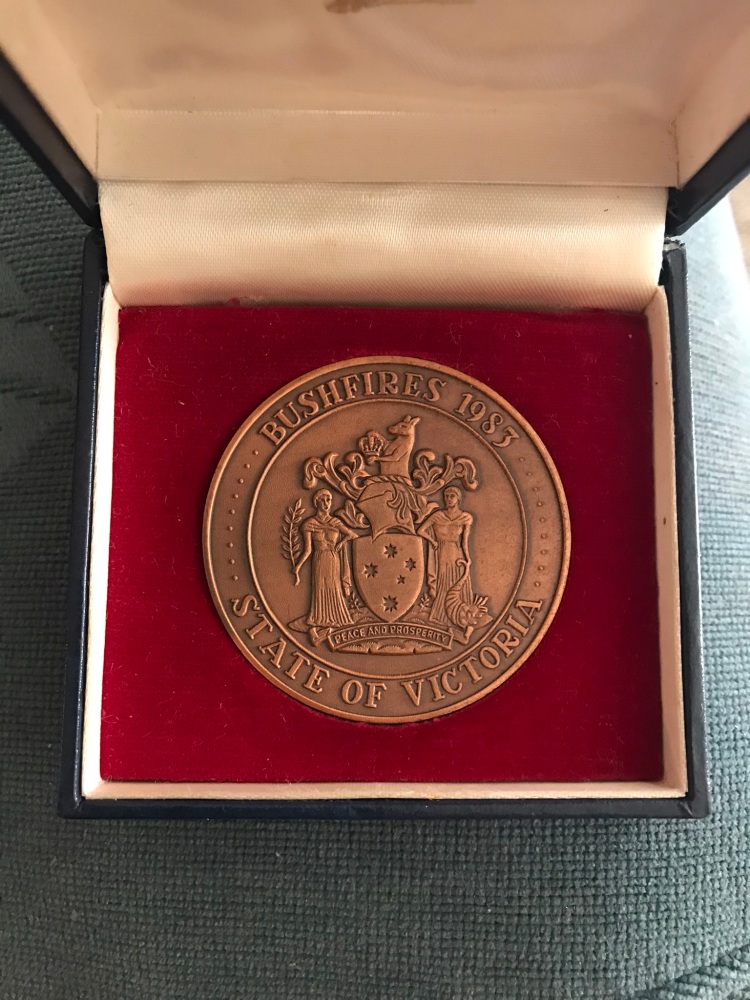
A plaque to commemorate Des and Alan was later unveiled at the Daylesford FCV office on 5 November 1983 by the Minister Rod Mackenzie. see below..
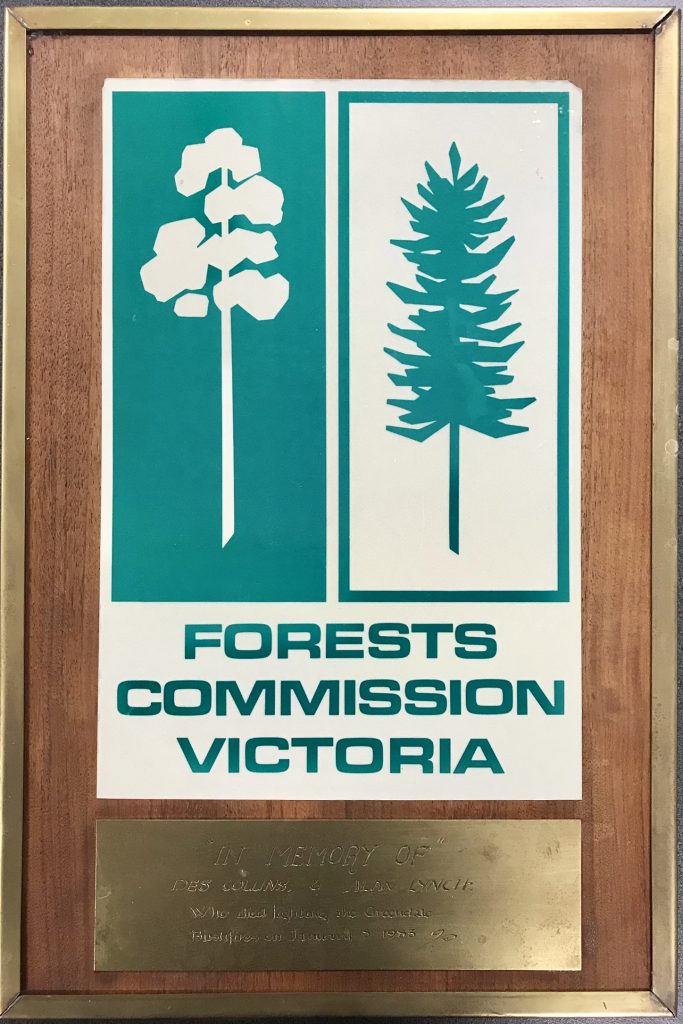
A major disruption for the Forests Commission occurred when suddenly, in mid-1983, the State Government announced the amalgamation of land management agencies to form the new Department of Conservation Forest and Lands (CFL). It came into legal effect on 2 November 1983 with a short Act of Parliament.
All the staff, resources and functions of the Commission were merged into a newly created department along with the Crown Lands and Survey Department, National Park Service, Soil Conservation Authority along with Fisheries and Wildlife.
Rod Mackenzie remained as the Minister while Professor Tony Edison, an English academic, was appointed the Director General of the new mega-department, which took many by surprise.
Throughout the difficult 1982-83 fire season Stan Duncan was the Commission’s Chief Fire Officer but he retired in 1984. The Chairman, Alan Threader also chose to retire, while the other Commissioners, Gerry Griffin and Ron Grose, took other roles.
Many other senior FCV staff chose to leave, which had significant long-term impacts on corporate knowledge and continuity.
However, the support from the Daylesford community and local FCV staff for both families was enduring, but it could never replace their loss.
About 20 years after the fire, the community of Greendale erected a picnic shelter at the local football ground to remember both Des and Alan.
The Greendale fire, and the tragic loss of two valued workmates, caused great heartache.
Everybody involved in the bushfire, and particularly John Nankervis, agonised about what they would have done, could have done, or should have done, to alter the tragic sequence of events.
But there were no simple answers, and everything always seems inevitable in hindsight.
The chronology of this fire was assembled 40 years after the event from newspaper accounts, FCV files held in the Public Records Office, the coroner’s report, witness statements, police reports, recollections and some limited interviews.
There are significant gaps, and sadly many of the key FCV staff are no longer alive or available to give their versions of events.
I would particularly like to thank Carol Collins for her support and for sharing her story and precious photo album.
Christine Lynch passed away in 2014 and is buried with Alan at Daylesford cemetery.
Ref: Coroner’s Report (VPRS 24/P0001, 1983/1022) – April 1983.

Greendale Fire -January 1983. From the Daylesford Forest District Fire reports held at Public Records Office of Victoria.
1. Solid red shading – fire boundary at 0800 am Saturday 8 January 1983
2. Red hatching – fire boundary at 1.00 pm on Saturday before the “blow up”
3. Outer red line – final fire boundary – 15,940 ha of forests and private land burnt – 10 January 1983.
4. Green shading – previous bushfires and Fuel Reduction Burning (FRB).Greendale Fire -January 1983. From the Daylesford Forest District Fire reports held at Public Records Office of Victoria.
1. The fire was reported to the FCV around 3 am on Saturday 8 January. Two other small fires were quickly controlled by the Ballan CFA.
2. The estimated Point of Origin (POI) on Greenhills Road is shown.
3. The fire burnt within State forest towards private property. By agreement, the FCV took control in the bush and the CFA on the open farm country.
4. The western boundary was Bee Track towards Garibaldi Hill and then south to the private property
5. Alan Lynch and Des Collins took the Komatsu D65A along the northeast flank of the fire heading east towards Dales Creek. They began at Greenhills Road around 7 am. This line was patrolled by FCV tankers, slip-ons and small Trentham FAD.
6. Des and Alan arrived at the steep drop-off into Dales Creek around 11.00 am and crossed with the intention of moving south to join up with the CFA in the farmland.
7. Had this plan been successful (solid red shading) the fire would have been only 120 ha.
8. Vehicles could not pass the drop-off.
9. Spot fires to the east of Dales Creek began around 11.30 am
10. The estimated fire boundary at 1.30 pm before the “blow up” is shown
11. Mass spotting occurred from around 1.30 pm. Fire moved southeast across open farmland towards Bacchus Marsh
12. The wind change hit at 3.30 pm and the fire blew out towards Gisborne.
Aerial photo from the Coroner’s Report– April 1983
1. Des and Alan were found with the Komatsu D65A about 30 m short of Charcoal Track (red star).
2. The control lines into Dales creek are clearly visible.
3. To the trained eye tree crown scorching can be seen near where the machine was found.
4. A large open area / quarry on private land can also be seen.
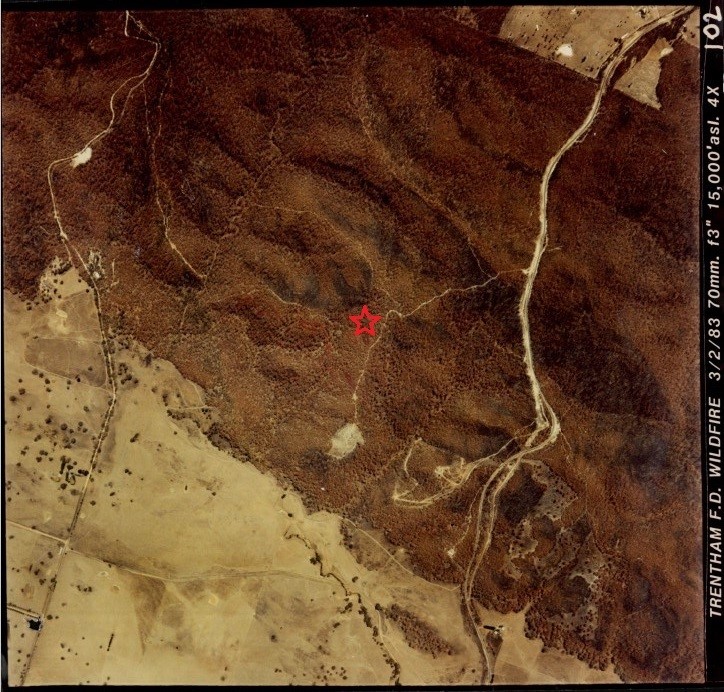
Map produced by Peter McHugh 2022
1. The fire point of origin on Greenhills Road is shown. The FCV operated in the bush while the CFA operated on the farmland
2. Alan Lynch and Des Collins took the Komatsu D65A along the flank the fire heading east towards Dales Creek. (Red dashed line)
3. They began at Greenhills Road around 7 am. This line was patrolled by FCV tankers, slip-ons and small Trentham FAD.
4. Des and Alan arrived at the steep drop-off into Dales Creek around 11.00 am and crossed with the intention of moving south to join up with the CFA in the farmland (light green shading).
5. Vehicles could not pass the drop-off.
6. Spot fires to the east of Dales Creek began around 11.30 am
7. Des and Alan began construction of a new trail flanking the fire towards charcoal track
8. The second FCV machine built a fallback line (green dashed line)
9. Their machine was found 30 m short of breaking through onto charcoal track
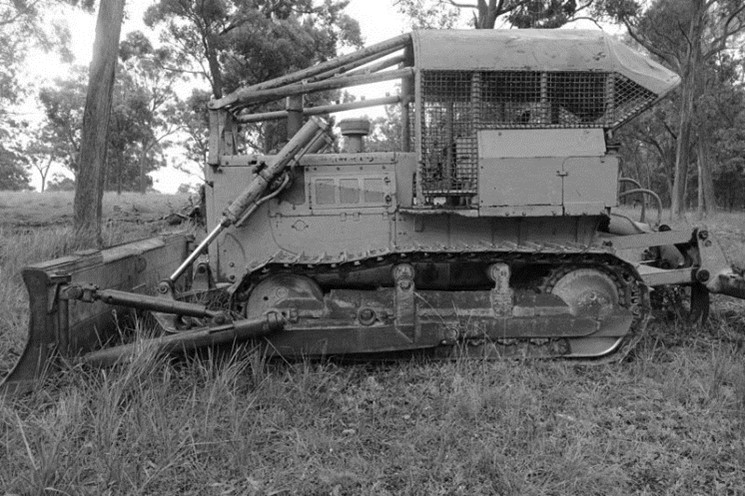
A Komatsu D65A fire fighting machine. Courtesy of the Forests Commission.
A frontal system off western Australia on Friday January 7 January brought predicted temperatures of 29 degrees to Melbourne on Saturday with a hot northly winds followed by a mild south westerly change during the afternoon or evening with a chance of a thundery shower. These represent moderate to high fire danger conditions and in combination with the drought affected the fire behavior.
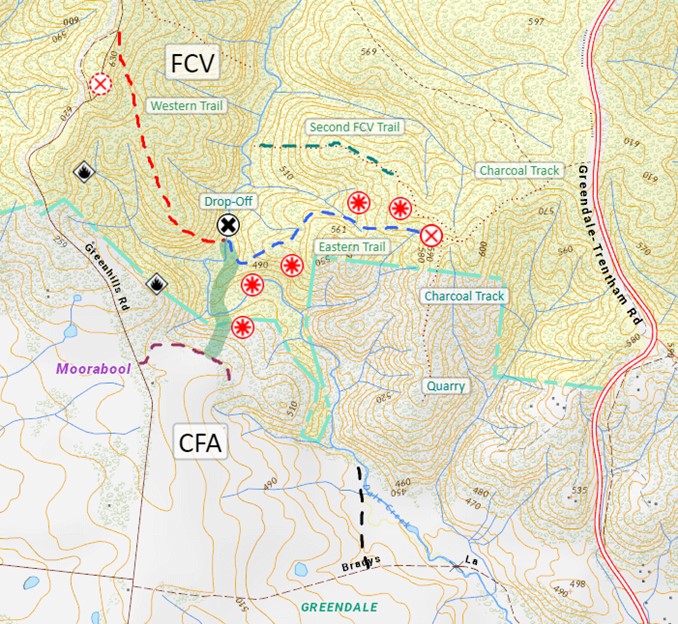
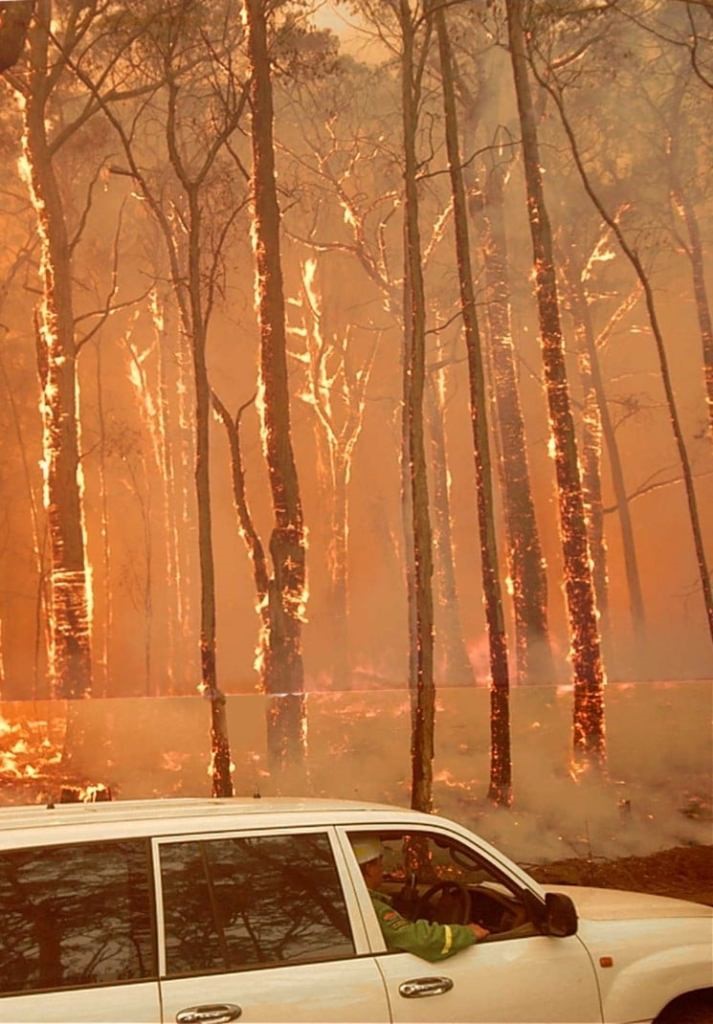
Messmate (E. obliqua) has a fine fibrous bark which is very prone to mass spotting when fuel moisture contents drop below 10%. Photo: Lee Gleeson
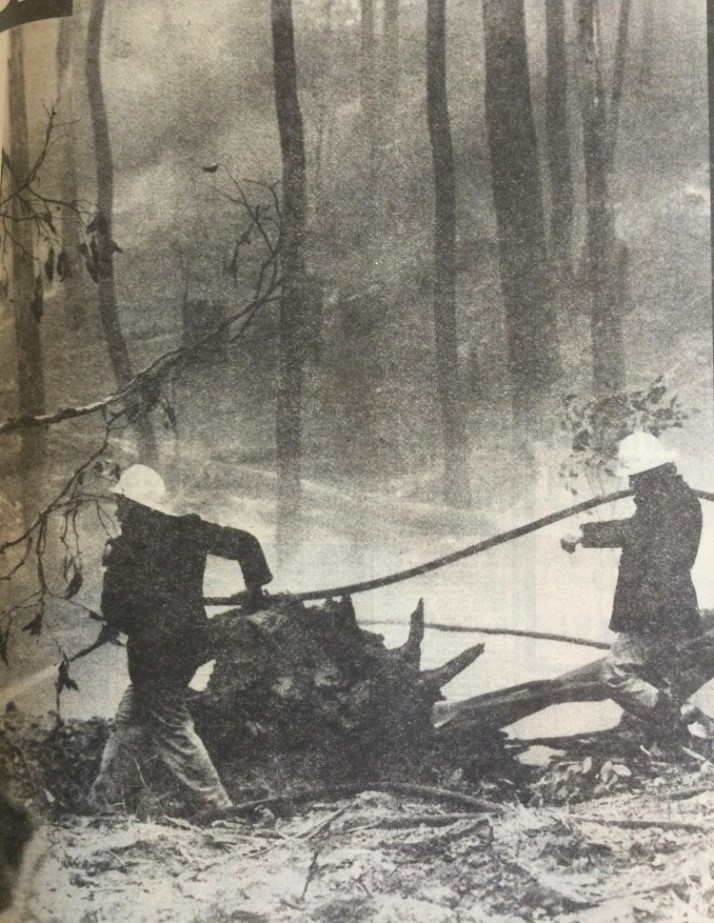
Sun news pictorial. Monday January 10, 1983 Greendale
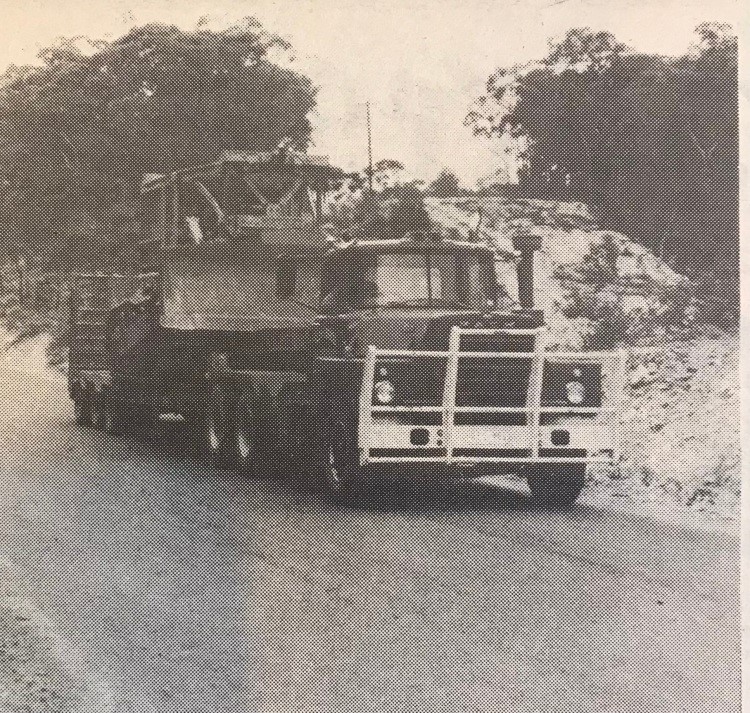
FCV float transporting a bulldozer into the Wombat State forest. Source:The Bacchus Marsh Express – Emergency edition 10 January Bacchus Marsh Mail – 11 January 1983.
Blackwood/Greendale fires where 2 men named Des Collins and Alan Lynch lost their lives at Long Gully in Greendale while creating a firebreak trail.
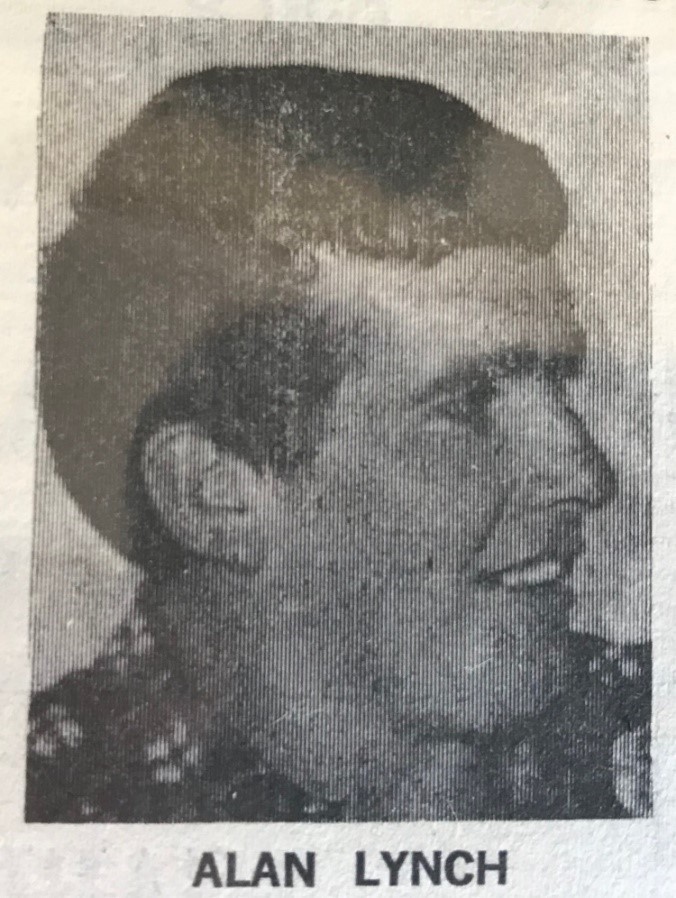
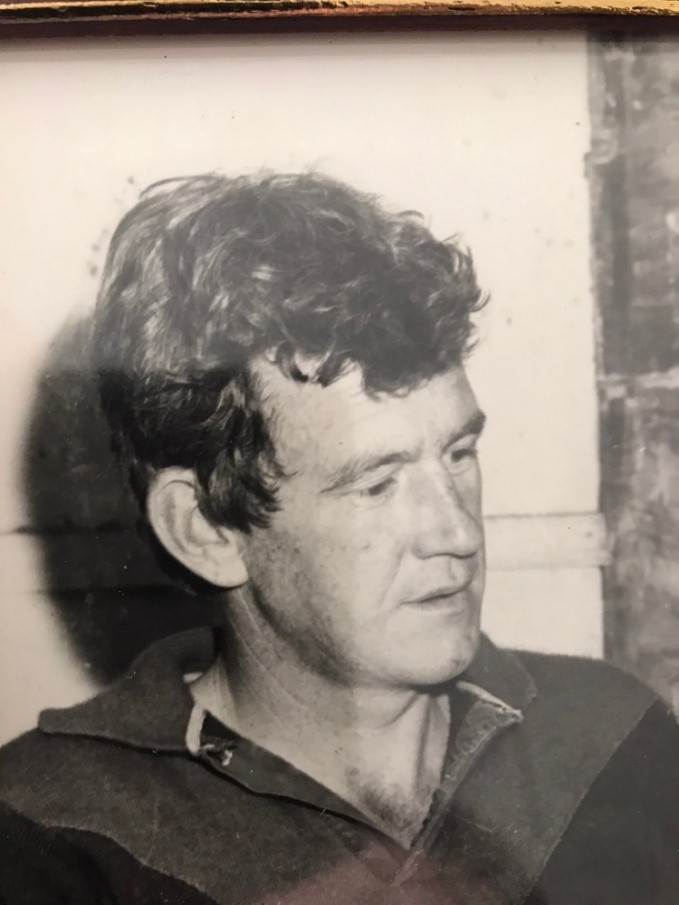
Des Collins.
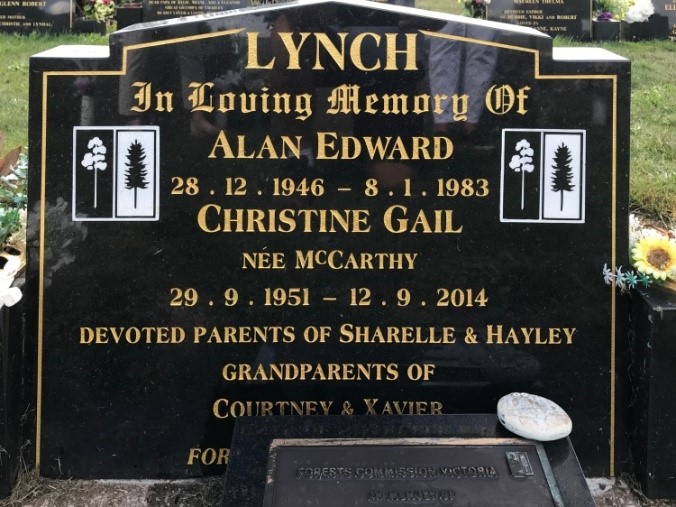
Daylesford cemetery. Photo: Peter McHugh 2022
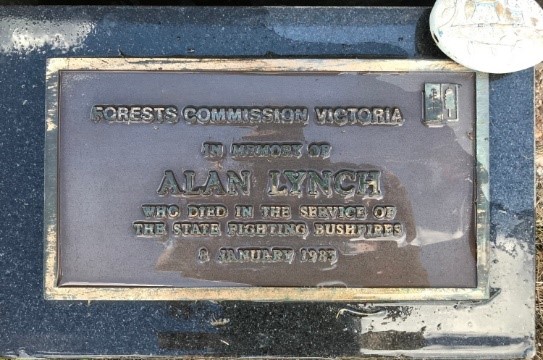
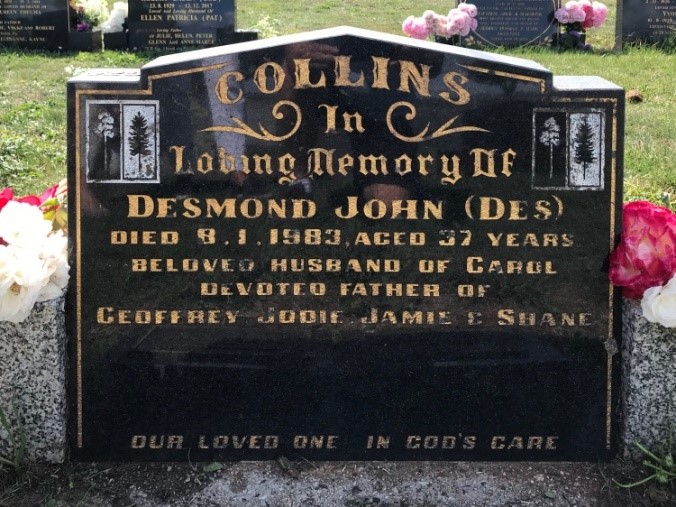
Daylesford cemetery. Photo: Peter McHugh 2022
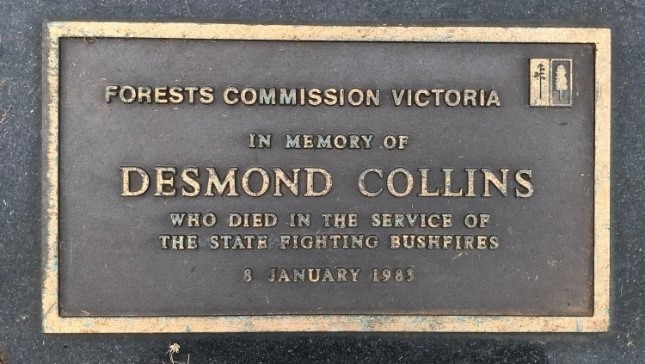

Plaque presented by the Forest Commission in November 1983 in the Daylesford office. Photo: Peter McHugh 2022.

Photo by Margot Hitchcock of Bruce and Philip Hitchcock viewing the burnt-out area of the bushfire in 1983.
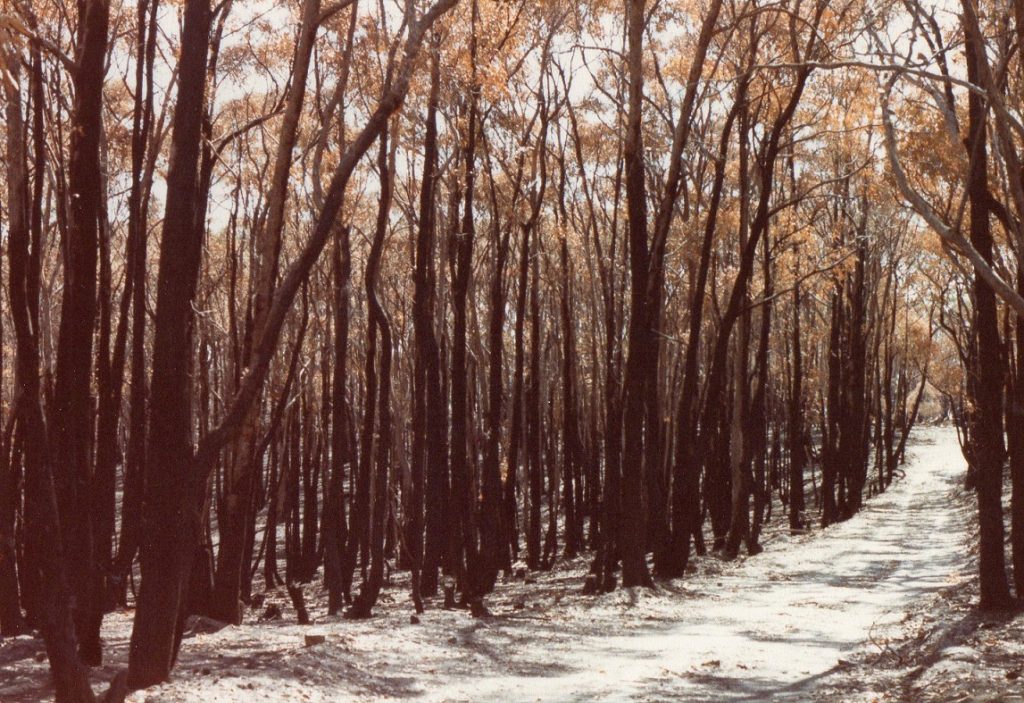
Photo by Margot Hitchcock of Mt Blackwood road, Blackwood and the bushfire damage in 1983.
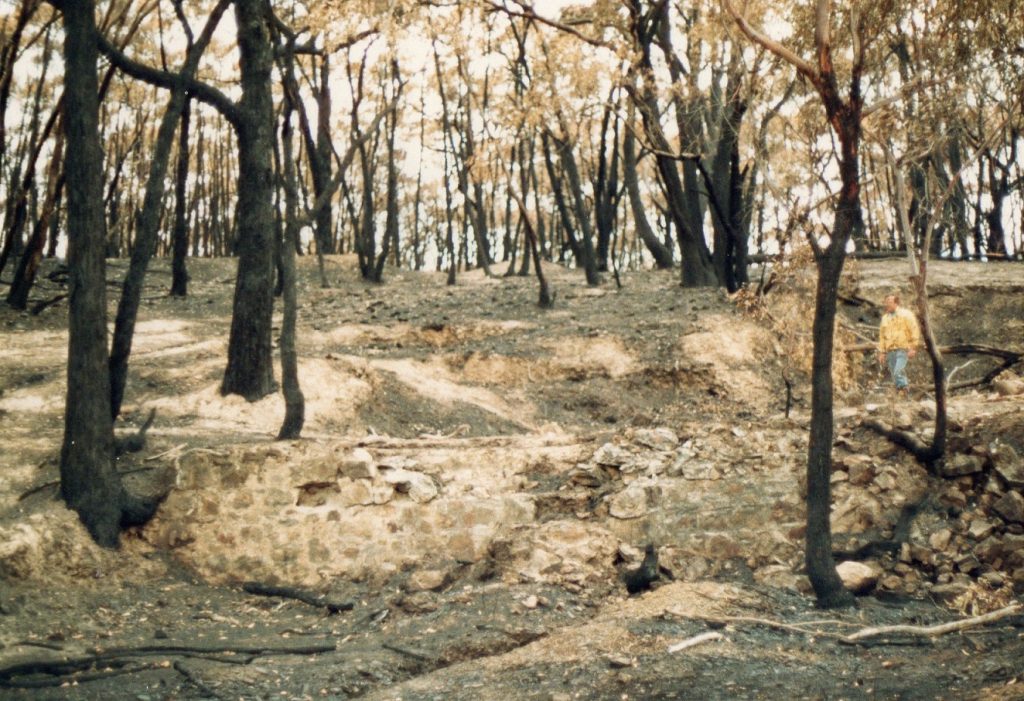
Photo by Margot Hitchcock of Bruce Hitchcock viewing the burnt-out area of the bushfires at the site of the Red, White and Blue Mine in Mt. Blackwood Road in 1983.
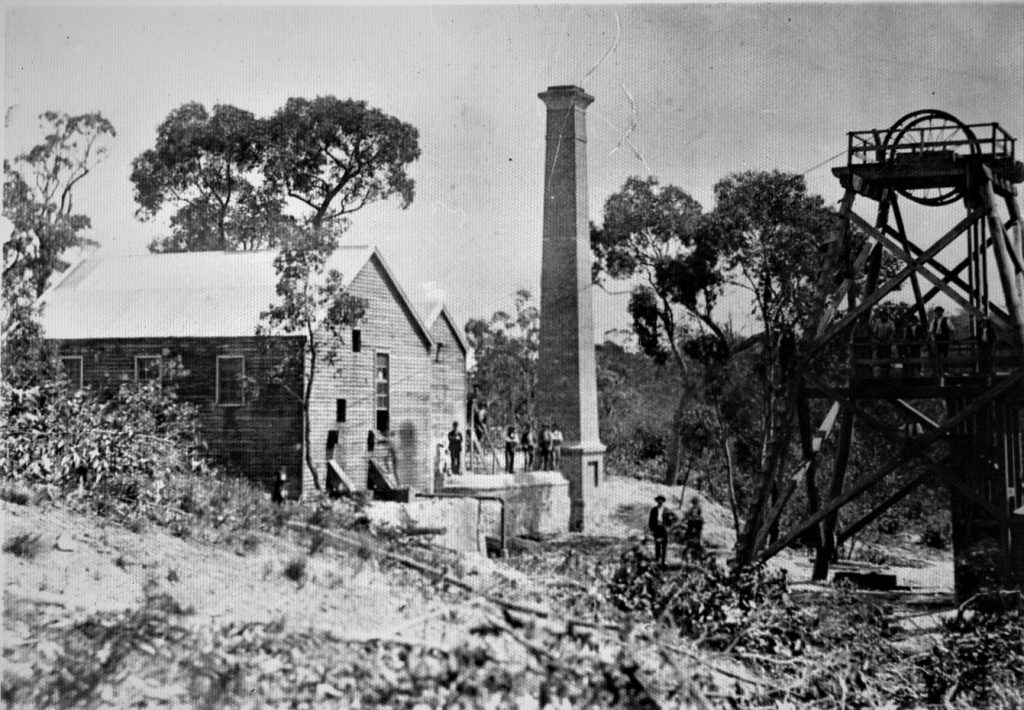
Red, White and Blue Mine in Mt. Blackwood Road, Blackwood when in operation C. 1890.
Photo courtesy of Margot Hitchcock. BDHS
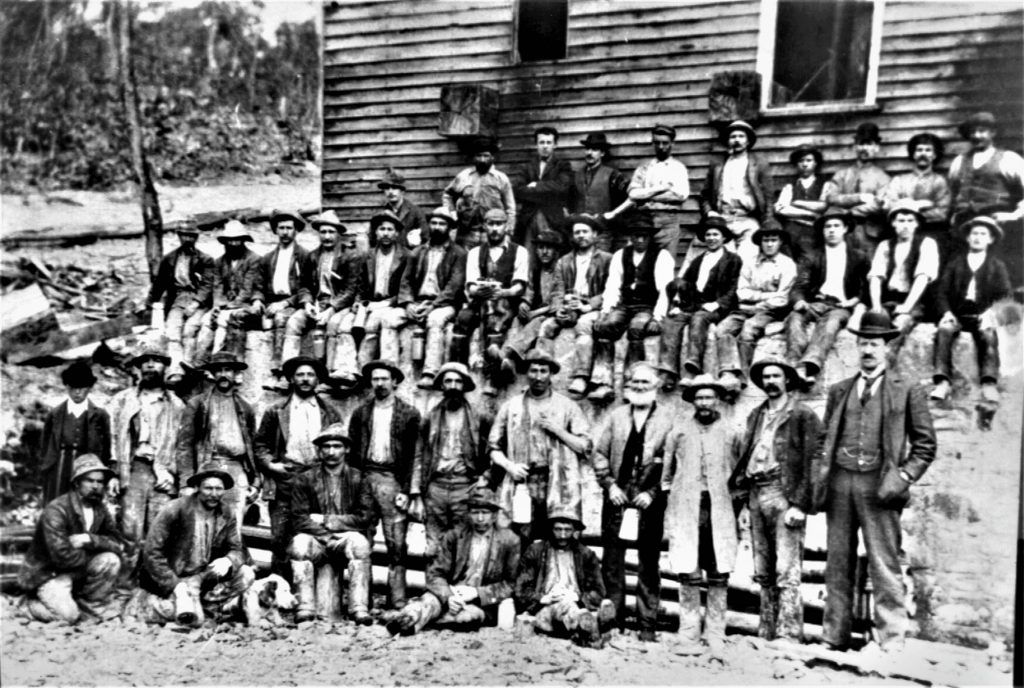
Red, White and Blue Mine in Mt. Blackwood Road, Blackwood when in operation with miners sitting on stone wall. C. 1890. (wall shown in fire damaged area above.)
Photo courtesy of Margot Hitchcock. BDHS.
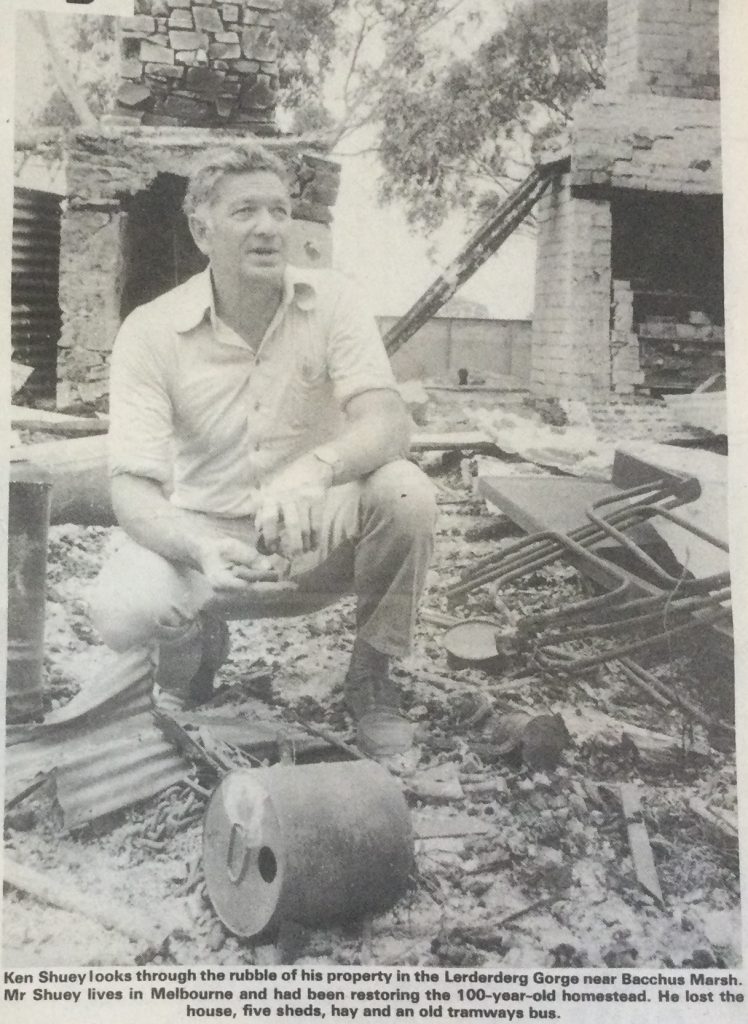
Ken Shuey who lost all his property in the Bush fires in Greendale. courtesy Melton Bacchus Marsh Newspaper.
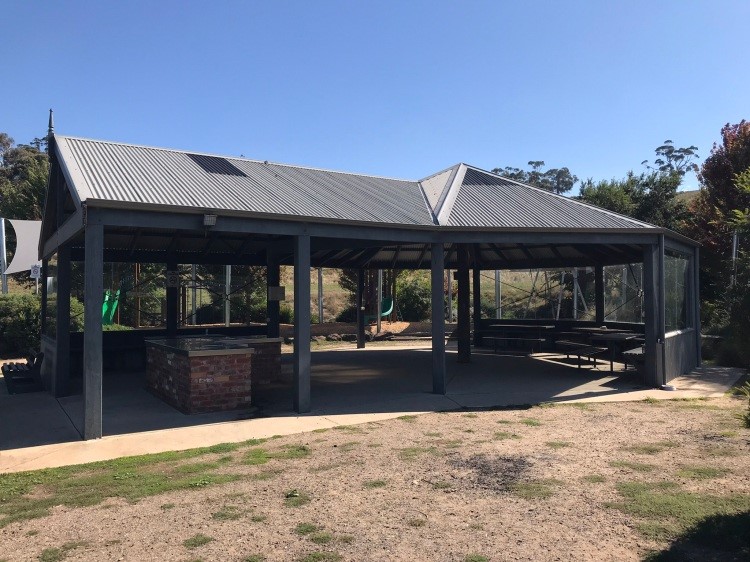
The Greendale picnic shelter was built by the community in about 2000. Photo: Peter McHugh .
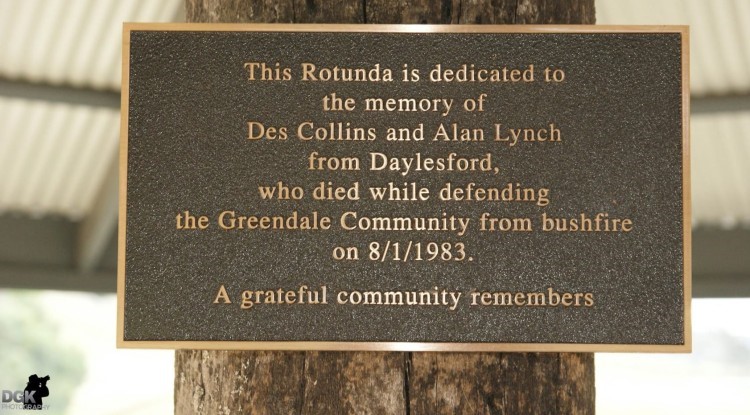
Above – Plaque in Rotunda in Greendale built by the Greendale Community to Honour two brave firefighters who lost their lives at Greendale in the bushfires in January 1983.
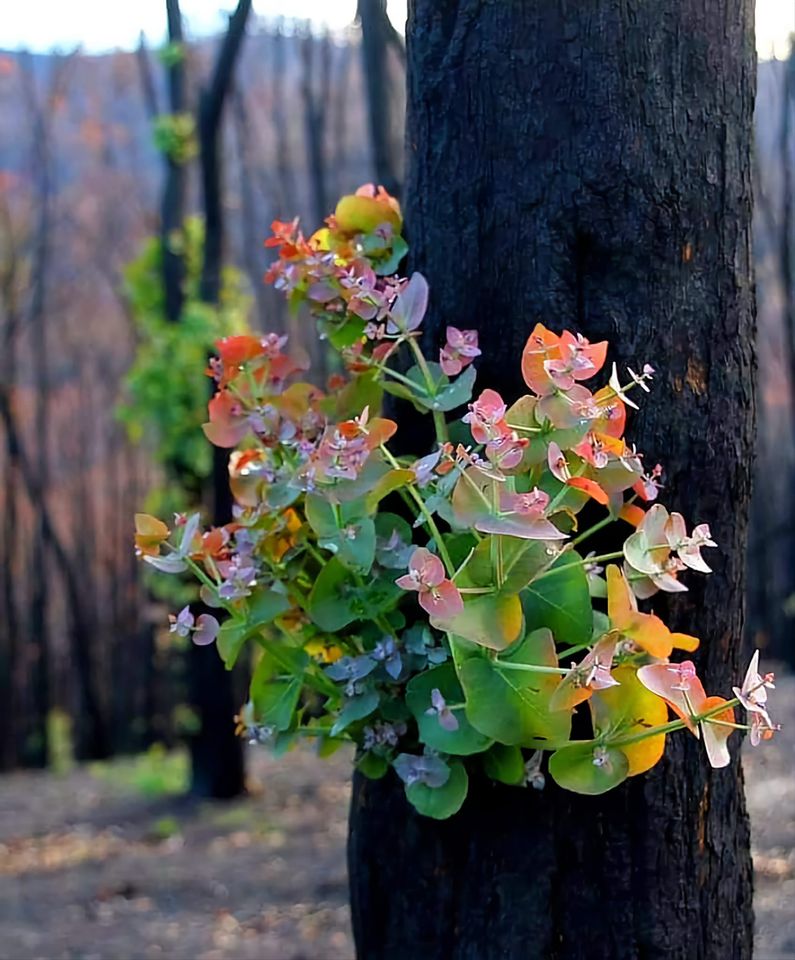
Bush Fire Recovery.
RESOURCES –
The 1982-83 Victorian Bushfire Season, including Ash Wednesday – 16 February 1983.October 5, 2022In “Forests”
Ash Wednesday – 16 February 1983.February 16, 2023In “Bushfire”
Major bushfires for the Forests Commission in 1982-83.June 22, 2022 In “Bushfire”


